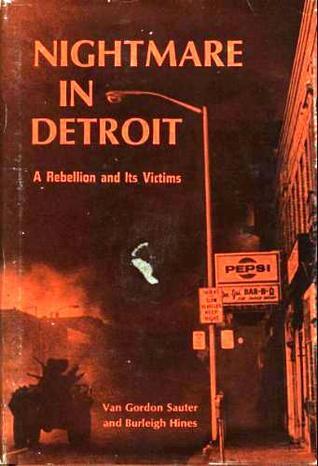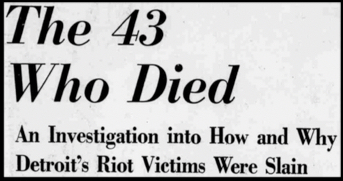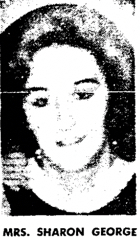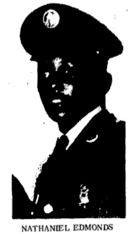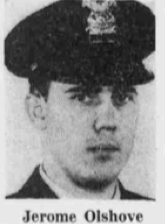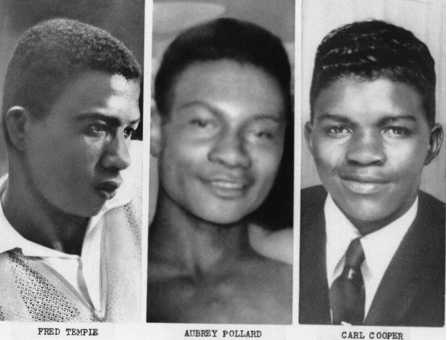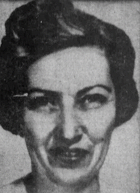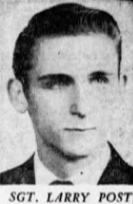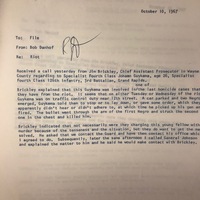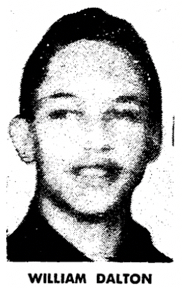Remembering the Casualties
During the 1967 Detroit Uprising, civilians, civil servants, and even children and teenagers lost their lives due to the ever-heightening fear and violence that ensued during those dark days in July. The official total is 43 dead, a number produced by the Detroit Police Department's Homicide Bureau and accepted by the city's mainstream newspapers. Our additional research in African American media sources and government documents resulted in a death toll of 47, as found on this page and in the interactive map on the previous page, which is probably still an undercount.
This page provides a detailed record of these 47 fatalities and a tribute to the those who died. Many accounts of the cause of death are contradictory, as law enforcement actors, and in some cases civilian witnesses, might have had incentives to distort or fabricate the stories. Reports from the Detroit Police Department and Michigan National Guard--officially responsible for 22 and 11 fatalities, respectively, but likely responsible for more--often omitted crucial details in order to disguise liability or guilt, and often criminalized the deceased by blaming their alleged 'looting' and 'sniping' for the outcome. It is also important to emphasize that even if some of the deceased were indeed 'looting' from stores, they were almost always unarmed and shot in the back as they fled, and stealing merchandise was a misdemeanor offense in a state without capital punishment--hardly justification for an execution in the street by DPD officers or National Guardsmen. The prosecutor legally justified these killings, however, because "breaking and entering" was a felony-level offense, and both DPD policy and Michigan law permitted use of force to stop a 'fleeing felon.'
A Pattern of Coverups. There is solid or strong evidence indicating that DPD officers or National Guardsmen on the scene covered up the circumstances of homicides in at least 21 cases, representing 60 percent of the 35 deaths attributed to law enforcement (this total includes Michigan State Police and U.S. Army fatalities). The materials in the public record make it clear that many investigations by the DPD Homicide Bureau and the Wayne County Prosecutor were not thorough or impartial. In multiple deaths, newspaper reporters interviewed eyewitnesses whose accounts directly contradicted the police version; most of the time, the DPD Homicide Bureau did not even try to interview these witnesses. As recounted below, the cases that strongly indicate coverups--often accompanied by the framing of victims as snipers, arsonists, or fleeing looters--include: Clifton Pryor, Robert Beal, Alphonso Smith, Richard Sims, Henry Denson, Ronald Evans, William Jones, Roy Banks, Arthur Johnson, Perry Williams, Tonia Blanding, John LeRoy, Audrey Pollard, Fred Temple, Carl Cooper, Helen Hall, Larry Post, George Talbert, Albert Robinson, William Dalton, and Ernest Roquemore.
The Wayne County Prosecutor exonerated police officers and military troops in all of these homicides except for the three Black teenagers killed at the Algiers Motel, and then only after the DPD coverup unraveled. The other 18 cases that our project believes were likely wrongful deaths range from innocent people killed by law enforcement crossfire then blamed on unknown snipers, to innocent pedestrians or motorists shot and killed by National Guardsmen who then sought to frame the victims, to innocent people shot as officers fired wildly and then unjustly classified them as alleged looters. All eleven of the homicides attributed to the Michigan National Guard were questionable or suspicious, revealing either coverups or accidents based on extreme indiscipline, often both. The prosecutor used the standard of 'absence of criminal intent' to exonerate National Guardsmen and DPD officers in every fatality classified as accidental, including those caused by firing wildly in violation of express orders; it is important to note that these were political and not strictly legal decisions, an prosecution for involuntary manslaughter does not require proof of malicious intent.
Fatalities in Custody. In addition, eyewitnesses insisted that four of the African American males whose homicides were declared 'justifiable' under the 'fleeing felon' rule were actually in the custody of Detroit police officers or National Guardsmen and murdered. These cases--Ronald Evans, William Jones, Albert Robinson, and William Dalton--did not become as infamous as the three teenagers murdered at the Algiers Motel, but the available evidence strongly suggests that at minimum, the prosecutor should have taken each to the grand jury. In each of these cases, newspaper reporters tracked down multiple eyewitnesses who contradicted the police version and whose accounts were either dismissed or never considered by the Homicide Bureau and Wayne County Prosecutor.
Key Sources. The book Nightmare in Detroit: A Rebellion and its Victims, published in 1968 by investigative journalists Van Gordon Sauter and Burleigh Hines, provides valuable accounts from witnesses to many of these fatalities, and personal memories of those who lost their lives from friends and family members, resulting in an important corrective to the initial incident reports in the Detroit newspapers, which came directly from the Detroit Police Department. The earliest compilations of "riot deaths" in the mainstream media, such as the list included in the Detroit News's special section "The Time of Tragedy" on August 11, 1967, were replete with misinformation. The Detroit Free Press did conduct a thorough and generally balanced investigation, "The 43 Who Died," published on Sept. 3, 1967, which provided significant additional evidence for the accounts below and includes eyewitness testimony and other evidence that indicates a pattern of coverups.
Sunday, July 23 (Four Fatalities)
All four of the people who died on July 23 were presumed or confirmed killed by the actions of other civilians, not law enforcement officials.
Willie Hunter and Price Williams
Willie Hunter and Prince Williams, both African American males in their twenties, were best friends and probably the first people to die during the Uprising. Both had been born in the South and moved to Detroit for work. The circumstances of their deaths are not clear, but they perished from carbon monoxide inhalation inside a drug store on 12th street that burned in the initial wave of fires set by arsonists. Their bodies were discovered by firefighters several days later. Witnesses recalled seeing the two men entering the store, and the authorities and media speculated that they were looters, but there is no direct evidence. Willie's wife Louise believed it was not possible.
Krikor (George) Messerlian
Krikor Messerlian was a 68-year-old immigrant from Armenia who moved to Detroit at age 20. He opened his own shoe repair shop on Brush Street, which was a primarily African American neighborhood, and then later moved to a storefront on Linwood. He lived out of the back of his store, and relatives described him as someone who "didn’t know how to back off when he was challenged." According to witnesses, a "gang" of Black youth confronted Messerlian around 4:30 pm on Sunday, the first day of the Uprising, and told him to leave his shop. He refused and grabbed a 20-inch sword that he kept for defense and cut one of the youth on the shoulder. Another person in the group, a Black male in his teens or early twenties, then began clubbing Messerlian, injuring him badly. Kirkor Messerlian died from his wounds on July 27. Several weeks later, the police arrested a 20-year-old Black male who was charged with murder.
Sharon George
Sharon George, a 23-year-old white woman, was shot around 11:30 p.m. while riding in a car on Woodward Ave. with her husband Ross driving. Mrs. George was pregnant and worked as a dancer near downtown. They had just dropped off two Black friends when they encountered an unruly crowd, and a shot rang out, striking Sharon George in the chest. She died later in the hospital. The police speculated that a sniper had shot her, but the homicide remained unsolved.
Monday, July 24 (Eighteen Fatalities)
Eleven of the fatalities on July 24, the deadliest day of the Uprising, were of unarmed alleged 'looters.' Most were African American men in their 30s and 40s; one was white. Eight were killed by DPD officers, sometimes acting alongside National Guardsmen; three were shot by private guards or store owners; one by a Michigan State Trooper. A number of the fatal shootings were questionable, and some involved clear coverups, but the prosecutor exonerated all of the law enforcement homicides. Michigan National Guardsmen killed two white men in undisciplined responses to 'sniper fire' reports: the unarmed Clifton Pryor, subsequently framed; and a firefighter accidentally shot in a crossfire.
Walter Grzanka
Walter Grzanka, a 45-year-old white male, was the son of immigrants from Poland. Soon after midnight, in the very early hours of Monday morning, Grzanka was apparently participating in the looting of a grocery store when the manager, Hamid Yacoub, shot him as he climbed through a window. Grzanka had cigars, tobacco packages, and shoelaces in his pockets when he died.
Clifton Pryor
Clifton Pryor was a 23-year-old white man who had moved to Detroit from Tennessee with his family to find work. Pryor and some other white men from his neighborhood went up on the roof of their apartment building around 2:45 am, presumably to watch what was happening and beware of the threat of arson. The apartment manager told them it was unsafe to stay up there, because they might be mistaken for snipers and someone in the group had a shotgun. On their way back down, National Guard Pfc. Gary Hutton fired on the group and shot Clifton Pryor on a landing. The Guardsmen present filed a report claiming that Pryor had been holding the shotgun when killed. Another civilian insisted that he had been instead, and the DPD Homicide Bureau changed the story to say only that "one of the men was armed with a shotgun." The group with Pryor also denied that the Guardsmen had yelled 'halt' or said anything before opening fire. Pryor's father traveled from Tennessee to clear his son's name and compiled the witness testimony denying that Clifton was either armed or a sniper, proving that the National Guardsmen had lied in their incident report.
John Ashby
John Ashby was a 24-year-old white male and a firefighter who was badly burned fighting a fire set by arsonists. He touched a power line while on a fire truck ladder around 3:30 am and died of his wounds several days later in the hospital.
Herman Ector
Herman Ector was a 30-year-old African American male who was shot by an unlicensed private guard, Waverly Solomon. Ector, a military veteran, was walking past a supermarket around 9:45 am, returning home from visiting his mother, when he got into an argument with Solomon. Ector criticized the way that the guard was treating several young Black males he accused of being looters, and Solomon smashed Ector with the butt of his rifle and then shot him dead. The DPD initially classified Herman Ector as a looter but brought murder charges against Waverly Solomon following an investigation (which was more thorough than investigations of alleged 'looters' shot by police officers or National Guardsmen). The prosecutor later dropped the charges even though Ector had not been a registered guard for more than a year and was not authorized to be watching the store.
Fred Williams
Fred Williams was a 49-year-old African American male who had moved to Detroit from Arkansas in the late 1940s and worked in construction. The Detroit Free Press called him "a blameless man doomed to death by an unknown arsonist." As fired spread in his neighborhood, Williams began moving the belongings of himself and his wife Louise to a neighbor's house when he was electrocuted by a live wire in an alley around 7 am. National Guardsmen later found his body and reported the incident as a suspected looter, but the autopsy revealed the truth.
Daniel Jennings
Daniel Jennings, an African American male and the father of 14 children, was shot and killed by the owner of a drug store in his West Side neighborhood. Jennings headed out at 5:30 am on Monday morning to look for construction work at the union hall, but he came away empty. Stanley Meszczenski, the store owner, had been guarding his business with a rifle nonstop since the previous afternoon. Then someone smashed in the front window and Meszczenski opened fire, shooting Daniel Jennings dead. Two other men were with Jennings at the time, and it is not clear who broke the window or whether Jennings himself was a looter, but they were allegedly entering the store. The prosecutor declared the shooting to be "justifiable" because the drug store owner was defending his property.
Robert Beal
Robert Beal, a 49-year old African American male, was shot and killed by DPD Patrolman Ernest Gilbert after allegedly refusing to halt while fleeing a looted store. Beal had moved to Michigan from Arkansas and was recently laid off as a truck lift operator in Pontiac. He apparently drove into Detroit to see what was going on, against his wife Earline's wishes. The law enforcement report said that a group of National Guardsmen and a single DPD officer, Patrolman Gilbert, spotted Robert Beal inside a drug store that had previously been looted and ordered him to surrender. The report then claimed that Beal "made a sudden move" toward the officers, and so Gilbert shot him. The Detroit Free Press investigation found that the DPD Homicide Bureau had altered the initial report from the officer on the scene, who said that he fired at a fleeing Beal from a vehicle outside, to fabricate a scenario where Beal had directly threatened the law enforcement officials. The Free Press also stated that this coverup did not seem necessary, because the prosecutor would have justified the fatal shooting based on the claim that Beal had stolen property and fled, without embellishment.
Joseph Chandler
Joseph Chandler, a 34-year-old African American male, was shot and killed by two white DPD officers, Patrolmen David Senak and David VanLoo, after he allegedly stole goods from a corner market. Chandler had moved to Detroit from Kentucky for a factory job and had a wife and seven children. The officers claimed that they caught Chandler looting and then chased him down an alley, firing when he refused to stop. They shot him as he climbed a fence but then left the scene, believing they had missed. Patrolman Senak and his partner were exonerated for killing the unarmed Joseph Chandler as he fled. Senak was later charged with conspiracy for his role in the murders of three Black youth in the Algiers Motel Incident a few days later and also shot and killed another Black male two days after that.
Herman Canty
Herman Canty, a 46-year-old African American male, was shot and killed by DPD officer Gilbert Stocker as he drove a truck away from a supermarket around 2:30 in the afternoon. Canty was a Georgia native who lived in Detroit with his wife and two kids and worked at a car wash in Ann Arbor. The initial police report of his death was vague: "man in truck is shot." Rumors circulated that the police had killed Canty while he was just driving down the street, but the Detroit Free Press investigation found a witness who said that Canty and three other people were stealing a large amount of contraband from the market. A contingent of DPD officers and National Guardsmen confronted the group, and Patrolman Stocker shot Canty in the neck as he drove away, allegedly refusing to halt on command. Friends and coworkers told the Free Press that Canty "wasn't the kind of man to be a looter," and the newspaper investigation attributed his death to the chaotic free-for-all atmosphere of July 24.
Alfred Peachlum
Alfred Peachlum was a 36-year-old African American male shot by DPD Patrolman Charles Carlson inside a supermarket. Peachlum was married with three children and worked as a welder for General Motors. He left the house on Monday with his cousin, against his wife's warning that "those National Guardsmen have been taught to kill and they don’t care." Around 4 pm, a DPD squad car observed two men inside the grocery store, and the officers, Patrolman Carlson and Patrolman James Lozon, opened fire. They said that Peachlum had something shiny in his hand, appearing to be a weapon, but it was actually beef wrapped in tin foil. Peachlum died of a gunshot to the chest, and stray police bullets also seriously injured two women who were in a house across the street, requiring a lengthy hospitalization.
Alphonso Smith
Alphonso Smith, a 35-year-old African American male, died in contested circumstances that brought accusations of a DPD coverup. Smith worked as a waiter in a restaurant and was well-respected by his coworkers. Around 4:15 pm Monday afternoon, DPD Patrolman Thomas Peterson shot and killed Smith inside a supermarket on suspicion of looting. The DPD Homicicde Bureau and the Wayne County Prosecutor found the death to be accidental, based on the officer's claim that he slipped on debris and his gun discharged without intent. Peterson and his partner, Patrolman Eugene Purchiaroni, also claimed that they ordered Smith and other men present to halt and that Smith had thrown a can at them. Witnesses disputed this version of events and insisted that Patrolman Peterson did not slip and instead fired through a broken window from outside the store. Frank Mosley, an African American man who was present and arrested on suspicion of looting, told reporters: "I saw everything. . . . He [Smith] didn't have anything in his hand. Nobody hollered halt. They jumped out of the car and shot." The Homicide Bureau did not bother to interview any of the civilian witnesses before submitting the report of an accidential shooting that the prosecutor then exonerated.
Nathaniel Edmunds
Nathaniel Edmunds was a 23-year-old African American male who had served in the Army and then got a job at Ford. He went to check on relatives on Monday afternoon and was murdered in his aunt's backyard by a white man, Richard Paul Shugar, who falsely accused Edmunds of looting and then shot him in an act of racist vigilante violence. Shugar yelled "why did you break into my store," even though he did not own a store and had no link to the nearby vacant building that he accused Edmunds and two other Black men of looting. Shugar, who lived a half mile away and was accompanied by another white man, then shot Nathaniel Edmunds in the chest and sped away. The DPD charged Shugar, and an all-white jury convicted him of second-degree murder. Edmunds's mother insisted that "it should have been first degree."
Mike Williams
Mike Williams was a 16-year-old African American male who lived in Highland Park. Little is known about Mike Williams, and he is not included in any of the official fatality totals compiled by the DPD and the newspapers. A Michigan State Police log states that Trooper Loren Roberts "shot two colored males in the act of looting a Westinghouse warehouse" at 2211 West Edsel Ford on the afternoon of July 24 because "they refused to stop on command." Mike Williams died on the scene at 5:40 pm. Roberts also shot William Moore, age 20, a resident of Middletown, Ohio, who was hospitalized at Receiving Hospital.
Edward Kemp
Edward (Charles) Kemp was a 35-year-old African American male shot and killed for allegedly stealing cigars from a market. Kemp had moved to Detroit in 1966 with his wife Betty and had two young children. DPD Patrolmen James O'Neil and James Dennerly, accompanied by a National Guardsman, shot Kemp from a patrol car as he fled and claimed that he did not halt on command. The prosecutor justified the shooting of the unarmed man who stole only cigars from a store that had already been thoroughly looted under the 'fleeing felon' rule.
Richard Sims
Richard Sims, a 35-year-old African American male who worked for Chrysler, was shot and killed by four officers in a police squad car around 8:30 pm after he allegedly tried to break into a bar. Sims and a companion started running away and the DPD officers chased after and shot him after they surrounded him in front of a locked door. The fatal shooting appeared to violate the use-of-force guidelines that permitted gunfire only if it was not possible to apprehend the unarmed suspect otherwise. The prosecutor nevertheless exonerated the DPD officers--William Flannery, Richard Mortenson, and Frank Fulmer--under the 'fleeing felon' provision.
Frank Tanner
Frank Tanner, a 19-year-old African American male, was shot by DPD officers and National Guardsmen who fired a hail of bullets at a group of youth allegedly stealing alcohol from a store. Tanner, who worked at a laundromat, was with friends around 9:30 pm and carrying a cardboard box down the street when the law enforcement contingent opened fire and shot him in the abdomen. He kept running and then lay wounded and dying all night long outside an apartment whose residents said they were too afraid of a curfew violation and being shot to go outside and help. The police came the next morning and took Tanner's body to the hospital where he was pronounced dead at 8:05 am. The store owner said Tanner was "a nice kid" and that 99% of the looters who took goods from his store were "nice people" whom he knew from around the neighborhood.
Carl Smith
Carl Smith was a 30-year-old white male and a Detroit firefighter with a wife and young son. He was shot in the head around 11:30 pm by a random bullet. The initial police reports blamed snipers, but it is probable that the bullet came from a National Guardsman. The autopsy report revealed that the bullet came from ground level, not from a rooftop where the snipers allegedly were based (reports of sniper fire were greatly exaggerated). After reports of "heavy sniper fire," DPD officers and National Guardsmen engaged in a "counter attack" against an unseen enemy and were firing wildly in multiple directions. The bullet came from a .30 caliber carbine, one of the two types of weapons carried by Michigan National Guardmen. The DPD Homicide Bureau investigation concluded that the most likely scenario was accidental 'friendly fire' from a National Guardsmen, as did media investigations.
George Franklin Shaw
George Franklin Shaw was a 26-year-old African American male who was shot by another civilian during an argument at Wildemere and Edsel Ford Drive. The Detroit News included his death as a "riot" fatality in its August 11, 1967, retrospective, but the Detroit Free Press did not in its own more thorough investigative report published Sept. 3, 1967.
July 25 (Eleven Fatalities)
Most of the ten fatalities on July 25 involved excessive or unjustified force followed by coverups by the DPD or Michigan National Guard or both. The Wayne County Prosecutor exonerated law enforcement officers in all of the questionable shootings. Two African American men, Henry Denson and Roy Banks, were clearly innocent and framed. Four others--Ronald Evans, William Jones, Arthur Johnson, Perry Williams--were victims of excessive police violence in circumstances where the official accounts were contradicted by witnesses or the forensic evidence or both. The National Guard homicide of Tonia Blanding was an operational failure at all levels. Guardsmen and DPD officers also accidentally killed Julian Dorsey, a Black man and private guard, while firing wildly at alleged looters. Even the death of the only DPD officer killed during the Uprising was likely caused by the unnecessary escalation of force by law enforcement.
Henry Denson
Henry Denson was a 27-year-old man African American male driving with two friends around 1 am when shot and killed by "trigger-happy" National Guardsmen who almost certainly fired without cause and then framed the victims. The group passed through a National Guard checkpoint* on Mack Avenue and then, as they came to a second one, a bullet pierced the car window and killed Denson. [*Many National Guard 'checkpoints' were not street barricades but just groups of Guardsmen standing on street corners, making it difficult for motorists to realize when they were approaching one.] Denson's companions, Harold Johnson and Michael Cooper, swore that the unidentified Guardsmen shot without justification as they were driving about 5 mph and complying with an order to halt. Johnson, the driver, was arrested and charged with felonious assault for allegedly threatening the Guardsmen with his vehicle. Two Newsweek reporters on the scene agreed that the assault charge was a fabrication and that a Guardsman had yelled "get 'em" as the car came to a stop. The National Guard and DPD Homicide Bureau claimed that the car "suddenly accelerated," causing two National Guardsmen to open fire. The prosecutor exonerated the Guardsmen, but a majority-white jury acquitted Harold Johnson of the assault charge, and his lawyers accused the DPD of framing him in order to justify the murder of Henry Denson.
Julius Dorsey
Julius Dorsey, a 55-year-old African American male who worked as a private security guard, was guarding a store from looters when he died. At one point earlier in the evening, he fired his pistol to frighten off some potential looters, and the shots caused both DPD officers and Michigan National Guardsmen to arrive. Around 1:15 am, either the DPD officers or the National Guardsmen shot and killed Dorsey when they started firing at alleged looters who were fleeing from the scene. He was sitting on a porch next door when he died. The DPD said that "unidentified personnel" had shot him accidentally, and the prosecutor also ruled his death an accident, requiring no further investigation, so the homicide of Julius Dorsey remained officially unsolved. It is not clear whether the DPD or the Michigan National Guard caused his death, but the available evidence points to the Guardsmen.
Manuel Cosbey
Emanuel Cosbey was a 26-year-old African American male who lived in the Sojourner Truth housing project and had lost his brother in Vietnam only a week before DPD officers shot and killed him as a "looter." Cosbey was married with a son and apparently went along with a crowd that decided to take advantage of the circumstances by stealing the merchandise from a nearby corner grocery. DPD officers responded to a looting call and opened fire at the unarmed suspects as they fled. Patrolman Jerome Palka killed Cosbey with a shot in the shoulder, and the police arrested four other 'looters.'
Ronald Evans and William Jones
Ronald Evans, 24-year-old African American male, and William Jones, a 23-year-old African American male, were shot and killed by DPD officers for stealing beer from a corner grocery. They broke into the store with two other men, apparently to celebrate Evans's birthday. The DPD and National Guard converged on the location and surrounded both Evans and Jones, holding them spread-eagled on the sidewalk. At some point Evans began running away, and DPD officers Lloyd Hewitt and Norman Salo, among others, shot at him 14 times. A dozen civilian witnesses were present, and at least four insisted that the police officers had racially abused Ronald Evans and forced him to flee so that they could kill him. There were 20 armed law enforcement officers at the scene when Evans got up and started to run, so it is implausible that they could not have apprehended the unarmed suspect without fatal force. The police officers then claimed that Jones, who was firmly in custody, tried to escape and so they shot him multiple times as he "ran out the door." This was a coverup, because Jones died with bullets in his chest and abdomen inside the store as officers blocked the doorway. Patrolman Chester Kotowicz apparently fired the fatal shots. The prosecutor exonerated the DPD officers despite the witness testimony and other evidence strongly indicating that the shooting was improper.
Jerome Olshove
Jerome Olshove was a 32-year-old white male and the only DPD officer to die during the Uprising. He responded to a looting report in a supermarket at 3 am, after a National Guardsman had shot one of the suspects in the face. Patrolman Olshove and other DPD officers detained several alleged looters, and then in a murky scuffle Olshove was killed by another officer's gun. The police report claimed that Danny Royster, a 20-year-old African American male being arrested, had resisted and grabbed the officer's gun, causing it to fire. A witness watching from her window instead insisted that Royster had been trying to surrender when the DPD officers began beating him, instigating the scuffle that cost Patrolman Olshove his life. The DPD charged Royster and also Charles Latimer, a 19-year-old African American male who was in handcuffs, with first degree murder.
Roy Banks
Roy Banks was a 46-year-old African American male who was shot without cause by National Guardsmen as he walked down the street. Banks, who was deaf since a child, was walking to catch the 4:30 am bus to go to work at his factory job when the Guardsmen opened fire. A witness said that a Guardsman yelled, "Shoot the sonofabitch, he's got no business out here anyway." After firing many rounds, the Guardsmen stood around talking, laughing, and smoking while Banks's body lay under a truck, to be discovered later. The Guardsmen said that Banks had kept running and ignored multiple orders to halt, which witnesses denied. The National Guard and DPD reported Banks's death as a suspected looter, but the owner of the tavern allegedly looted said this was not true. The owner gave a statement to the Homicide Bureau, which did not include it in the official report.The DPD Homicide Bureau also misstated the location of Banks's body to make it seem closer to the store rather than near his house. The forensic evidence contradicted the law enforcement account that Banks was fleeing and shot in the back, since the bullet wounds in his groin and knee were from the front. Banks died of his wounds on August 14. The evidence strongly indicates that the Michigan National Guard and Detroit Police Department conspired to cover up the circumstances of his wrongful death.
Arthur Johnson and Perry Williams
Arthur Johnson, a 36-year-old African American male, and Perry Williams, a 33-year-old African American male, were shot and killed by DPD officers and then framed as 'looters' in a probable coverup. The men, both impoverished high school dropouts, were standing near a pawn shop that had already been looted repeatedly when police officers began shooting at them, so they ran inside for cover. Then four officers entered the building and shot them at close range, possibly less that 12 inches away, according to the autopsy report. The DPD officers--Lawrence Giacobozzi, Lawrence Pew, Andrew Zazula, Edward Ruppell--claimed that they entered the pawn shop and opened fire when a man with a "long, dark object" threatened them. Patrolman Giacobozzi shot Perry Williams twice in the chest. The officers did not produce the club that they claimed Williams was wielding. Patrolman Zazula killed Arthur Johnson with two shots to the chest with his private 12-gauge shotgun. The four officers then left the scene without waiting for other officers to respond and transport those wounded to the hospital, as was protocol for homicides. They further did not call in the shootings in the police log. Later two other officers arrived and took the deceased to Detroit General Hospital. Nobody else witnessed the fatal shootings, but the forensic evidence and failure to follow standard procedures raises hard questions that the DPD Homicide Bureau and Wayne County Prosecutor declined to pursue.
Jack Sydnor
Jack Sydnor was a 38-year-old African American man who lived near 12th Street, the epicenter of the Uprising. He was inebriated a little after 9 pm when he started firing a .32 caliber pistol out the third-story window of his apartment building. The Detroit Free Press called Sydnor the only "confirmed" sniper among the fatalities, but he was not motivated by any political cause. Other tenants called the police, who stormed the building along with National Guardsmen. As the police entered his apartment, Sydnor shot and wounded Patrolman Roger Polke. Multiple officers opened fire and shot Sydnor in the chest and abdomen, and they also used tear gas to force him out. Sydnor ended up jumping out of the window and dying either from the gunshot wounds or the fall or both.
Tonia Blanding
Tonia Blanding was a 4-year-old African American girl who lived on 12th Street, near the epicenter of the unrest, and liked to dance in her floral dresses on the corner. She loved finding people to play with and spent a lot of time at a nearby beauty shop. Once the Uprising began, Tonia was forced to stay in the house in the dark with her family, waiting for the chaos to pass. Outside, false rumors spread of snipers shooting at police and National Guardsmen. On July 25, a National Guard tank rolled down Tonia's street and opened machine gun fire into her upper-floor apartment. Someone in the apartment allegedly lit a cigarette, which the men in the tank mistook for sniper fire--at least this is the National Guard's explanation for its military attack on a residential building. Tonia was huddled in the darkness playing with a toy. She was with her mother and father, uncle, cousin, and several other children. After multiple rounds of machine gun fire, residents begged the National Guard to stop. Everyone evacuated the building, except for Tonia. The ambulance took a very long time to pick up Tonia’s body. The police claimed that the presumed sniper hiding in the building must have escaped. A high-ranking DPD officer said, "The little girl’s death was regrettable." The Wayne County Prosecutor ruled the killing of Tonia Blanding by tank gunner Sgt. Mortimer J. LaBlanc to be a "justifiable" homicide based on the alleged sniper fire.
July 26 (Ten Fatalities)
Three of the fatalities on July 26 resulted in prosecutions of law enforcement officers, but eight of the ten were deeply suspicious or questionable as the pattern on this date involved excessive and unjustified force covered up by the DPD and/or the Michigan National Guard. In addition to the three Black teenagers murdered by DPD officers at the Algiers Motel, the evidence indicates that National Guardsmen killed Albert Robinson when he was unarmed and completely innocent. Four other people--two Black men, a middle-aged white woman, and a white National Guardsmen--were killed by undisciplined National Guardsmen firing wildly at alleged threats. The circumstances of all these homicides were covered up. The other two fatalities were of unarmed Black males involved in alleged petty theft.
John LeRoy
John LeRoy was a 30-year-old African American male ambushed and killed by Michigan National Guardsmen without cause. He had moved to Detroit from Tennessee as a boy and was married and worked at Chrysler. LeRoy was hanging out with four other friends at the home of Charles Dunson, and they decided to go check on one of the other friend's very pregnant wife. With Dunson driving, the five men passed through one National Guard checkpoint and explained why they were out after curfew, receiving permission to proceed. Then along their route, they came upon a National Guard jeep, and the Guardsmen opened fire without warning. At least 17 bullets struck their car, as the men screamed, "We didn't do anything." John LeRoy was badly wounded and died in the hospital three days later. His friend Charles Dunson, the driver, was shot in the face. Ronald Powers, whose wife was pregnant, had a bullet in the back and slugs in his head. As the men yelled for help, people who lived on the street tried to assist, but the Guardsmen threatened to shoot them if they did not stay in their homes. Dunson stated that the Guardmen refused to transport them to the hospital and that one said, "Shut up or we'll shoot some more." Dunson also said that they did not hear a command to halt but even after he stopped the car, "they still shot us to pieces." The National Guardsmen claimed that the men in the car ran a checkpoint and that someone fired a shot from the vehicle. This was a complete fabrication, as multiple witnesses both in the car and watching from their homes attested, and no weapon was found in the car. Prosecutor William Cahalan exonerated seven National Guardsmen for the homicide of John LeRoy because, although the evidence revealed that no shot was fired from the car, the Guardsmen "had reasonable grounds to believe it was."
Note: A photographer from NEWSWEEK, Dennis Brack, took a picture of a wounded and bleeding John LeRoy lying on the ground looking up at the camera that ran as a full-page image in the magazine. In communication with our project, Mr. Brack recalled that a National Guardsman "jammed a rifle under my chin" and said if he used a flash again, "he was going to blow my brains out." Our project is not reproducing the photograph of John LeRoy because of its sensitive nature.
Aubrey Pollard, Fred Temple, and Carl Cooper
Aubrey Pollard, Fred Temple, and Carl Cooper were African American teenagers ages 19, 18, and 17, respectively. They were murdered by white DPD officers at the Algiers Motel in the early morning hours of July 26 (visit the "Murder at Algiers Motel" page for the full story). All three either worked for Ford or had recently been laid off. They were at the Algiers Motel with two white females and two other Black males, just hanging out, when a contingent of white DPD officers and National Guardsmen fired many rounds into the building and then stormed the premises allegedly looking for snipers. The law enforcement officers brutalized, tortured, and racially abused the unarmed and innocent Black youth inside. The three teenagers who were killed died from close-range shots while in defenseless positions. The DPD officers and other law enforcement present covered up what happened but it eventually unraveled. Patrolman Ronald August shot and killed Aubrey Pollard and was prosecuted for murder but acquitted by an all-white jury. Patrolman Robert Paille was prosecuted for the murder of Fred Temple but a judge dismissed the case because the DPD Homicide Bureau had extracted his confession without reading him his constitutional rights. Patrolman David Senak, who was the ringleader and almost certainly killed Carl Cooper (as well as two other Black men in separate incidents during the Uprising), was prosecuted for conspiracy, but a judge also dismissed this case.
Helen Hall
Helen Hall, a 51-year-old white woman, was in Detroit on a business trip and staying at the Harlan House Motel next to the Lodge Freeway when National Guardmen and DPD officers fired more than 80 rounds into the building in an attack on nonexistent snipers and ended her life around 1 am. She was with other hotel guests looking out the window at a tank when a .30 caliber bullet, matching the rifles carried by many Guardsmen, pierced her heart. The DPD Homicide Bureau conducted an investigation that seemed determined to prove that an unknown sniper had killed Helen Hall, although the Free Press investigation found that almost all of the buildings that the police theorized were the sniper's hideout were either inaccessible or had no direct angle. The Homicide Bureau declined to conclude what all of the forensic evidence clearly revealed: that the bullet had come from one of the DPD officers or National Guardsmen shooting round after round into the Harlan Hotel that night, and given the caliber, most likely a National Guardsman.
Larry Post
Larry Post, a 26-year-old white male, was a deployed member of the Michigan National Guard and was accidentally shot by other unidentified Guardsmen, followed by a police coverup and framing of three young white males for the homicide. The threesome--Ronald Schuster, John McErlane, and Gary Mezceg--were in their early twenties and out after curfew to check out the scenes of unrest on the West Side of Detroit. The police investigation claimed that the youth ran through a National Guard roadblock, so the Guardsmen opened fire. When the car stopped, it contained no weapons. A while later, the Guardsmen discovered Larry Post dying on the ground with a bullet in the back. The three youth claim that there was no roadblock and the Guardsmen just opened fire without warning. Then DPD officers took the threesome to the 10th Precinct and beat them severely with blackjacks, breaking Mezceg's jaw and requiring hospital treatment for all of them. The DPD charged the three with assault with intent to murder, but the propsecutor reduced this to a curfew violation.
George Talbert
George Talbert was a 20-year-old African American from Detroit who was shot without cause and then framed by a National Guardsmen. Talbert and his wife, Barbara, had two children, and he had worked in a factory and as a TV repairman. On Wednesday around 5 pm, Talbert and his friend Lance Smith decided to head down 12th Street to see the damage. The area was tense when they arrived, with National Guardsmen screaming obscenities and firing multiple warning shots at Black motorists and people on the porches of their houses, ordering them to retreat (even though the evening curfew was not in effect and no one was breaking any laws). Talbert and Smith had parked their car and were proceeding on foot down LaSalle Gardens South when Specialist Johann Guykema, a National Guardsman from Grand Rapids, opened fire and wounded him with a rifle shot. (A bullet also hit Lance Smith in the shoulder). Talbert was completely unaware of what was happening and later told his family that he must have been shot by a sniper. Julian Witherspoon, who lived nearby, told news reporters and the authorities that he was an "eyewitness to murder" and that the Guardsman shot George Talbert for no reason. Multiple residents of the neighborhood corroborated Witherspoon's account and also said that the National Guard contingent, including a captain, refused to let them take George Talbert to the hospital until two Catholic priests intervened. He died ten days later from his injuries. The Michigan National Guard attempted to cover up the incident, and Specialist Johann Guykema claimed that Talbert and Smith had been charging at him and that one of them had said, "I'm going to cut your throat, you sonofabitch." This was a fabrication, as multiple witnesses attested, and the Detroit Free Press investigation said that Talbert was "unarmed and innocent" and "had a legal right to be where he was" when killed. Wayne County Prosecutor William Cahalan declared the homicide of George Talbert to be "justifiable," despite clear evidence that the prosecutor's office recognized that it was not, "because of the tenseness and the situation." The memo at right, from the office of Gov. Romney, indicates that the prosecutor's office recognized that the shooting was unjustified but did not want to charge any National Guardsmen (or DPD officers) for any actions that they took out in the streets.
Willie McDaniels
Willie McDaniels was a 23-year-old African American male who moved to Detroit from Birmingham, had a wife and two children, and worked in a factory. He was shot and killed in a murky afternoon incident on the East Side when police officers began firing at looters and nonexistent snipers. Two witnesses stated that McDaniels was not participating in the looting, and one insisted that he was. He was found dying on the ground with a bullet in the head. The police initially blamed snipers, but an officer almost certainly shot him from behind as he fled, unarmed, allegedly with two stolen lamps. The Wayne County Prosecutor justified the shooting of the unarmed man who, at worst, was participating in what the Free Press labeled a "crowd of holiday-spirited looters."
Julius Lust
Julius Lust was a 26-year-old white male killed by DPD officers in a junkyard while Lust and two friends were scavenging for auto parts. He was a high school dropout and carpenter who often worked on friends' cars for free. Lust told his friends that the owner had given him permission to enter the junkyard after hours. DPD Patrolman Robert Wrathell and Frederick Robinson ordered Lust to halt at gunpoint and then fired and killed him after claiming that he "made some sort of motion" with his left hand.
Albert Robinson
Albert Robinson was a 38-year-old African American man and military veteran who worked at Chrysler and lived in Hamtramck. He was killed by National Guardsmen who entered his apartment searching for alleged snipers and then abused Robinson and concocted a cover story. Witnesses said that Robinson was taking out the trash when the Guardsmen tortured and kicked him, stuck him with a bayonet multiple times, used racist slurs, and asked "How does that feel?" and "Aren't you dead yet?" Before he died, while in the hospital, Robinson told investigators that the Guardsmen shot him while he was lying on the ground. The Guardsmen and the DPD incident report stated that Robinson was a sniper who was shot while trying to escape and that he grabbed for the weapon of one Guardsman. No weapons were found in Robinson's apartment. The Homicide Bureau claimed that Robinson had not suffered any bayonet wounds, but the autopsy by the Wayne County Medical Examiner disproved this cover story. Then the Guardsmen said Robinson had been poked with a bayonet when trying to grab the weapon, except the bayonet wounds were in the back. The DPD Homicide Bureau almost certainly participated in a coverup of the Guardsmen's actions, which arguably constituted murder.
July 28 (Two Fatalities)
The fatal shooting of teenager William Dalton is less well known than the Algiers Motel Incident but arguably a similar example of a violent, racist conspiracy by a large group of law enforcement officers. Given the testimony of more than a half-dozen witnesses, the case indisputably should have gone to the grand jury to consider an indictment.
William Dalton
William Dalton was a 19-year-old African American male who multiple witnesses insisted was murdered by a DPD officer. The police initially classified his death as caused by sniper fire, and the story began to emerge only weeks later. Dalton lived on the West Side and was walking to visit a friend a few doors down around midnight when a group of DPD officers detained him for a curfew violation. They accused him of being an arsonist and looter. Dalton protested that he hadn't done anything, and one white officer then said, according to an eyewitness, "Shut up you sonofabitch, or I’ll blow your goddamn brains out. I oughtta do it anyways. Why don’t you run?" The police claimed that nobody said this and Dalton was shot while trying to escape, making the homicide "justifiable." Multiple witnesses instead insisted that Dalton refused to run, and so the officers took him into a back alley and then they heard a single shot. Another person who witnessed what happened in the alley said that the officers put a shotgun to Dalton's body and ordered him to run, and then an unidentified officer killed him from behind with a single bullet. Yet another eyewitness said that he yelled out of his window, "Don't shoot that boy" and a police officer replied, "Shut up, or I'll blast you're head off." There were about 15-20 DPD officers and National Guardsmen on the scene when the unidentified officer killed William Dalton. One of them then yelled, "let's get out of here," and they all left quickly, without reporting the death. The DPD Homicide Bureau covered up what happened--these witness accounts are from the Free Press investigation--and only belated identified the officer who fired as Patrolman Ronald Karchefski. The Wayne County Prosecutor declared the fatal shooting of a youth whom witnesses swore was in police custody, and that the officers on the scene violated regulations in failing to report, as "justifiable" based on the DPD claim that William Dalton was an arson suspect and fleeing when shot.
Palmer Gray, Jr.
Palmer Gray, Jr., was a 21-year-old African American shot and killed by Patrolman David Senak, who had previously fatally shot Joseph Chandler and probably also killed Carl Cooper in the Algiers Motel Incident. Unlike Chandler and Cooper, Palmer Gray, Jr., was armed. The incident occurred after Gray, Jr., became involved in a fight with his father, Palmer Gray, Sr., at the father's home. Gray, Jr., had a gun and threatened to kill everyone present, and so his mother called the police. Patrolman Senak arrived and told Gray, Jr., to drop his weapon and surrender. Senak shot and killed Palmer Gray, Jr., after the suspect allegedly refused and reached into his pocket.
July 29
The evidence is overwhelming that the DPD, Army paratroopers, and Wayne County prosecutor covered up the circumstances of the fatal shooting of Ernest Roquemore.
Ernest Roquemore
Ernest Roquemore was a 19-year-old African American male and the only person killed by a U.S. Army paratrooper during the military occupation of Detroit. He was shot in the back by Sp. 4th Cpl. Randolph Smith of the 82nd Airborne when paratroopers accompanied by DPD officers stormed the building looking for looters and began firing wildly at a crowd of at least a dozen Black youth who fled in fear, killing Ernest Roquemore. Three other teenagers suffered gunshot injuries: a 13-year-old female, a 17-year-old female, and an 18-year-old male whose leg was amputated. The law enforcement contingent claimed that they fired because a person was holding a gun, but this turned out to be a transistor radio. The DPD report claimed that Roquemore ran "into the line of fire," and the Wayne County Prosecutor ruled the homicide "justifiable" based on this allegation that Roquemore's actions caused the accidential death. This was not what happened, according to multiple witnesses present. Roquemore died with a bullet in the back, which contradicted the police insistence that he had been shot as he ran between the paratroopers and the alleged gunman. Kenneth Randle, the 16-year-old youth holding the transistor radio, told his story to the newspapers, but neither the DPD Homicide Bureau nor the prosecutor bothered to interview him. "It isn't true what they say about Roquemore [running into the line of fire]," Randle told the Free Press reporters, "because it was me they were supposed to be shooting at, and he was shot and lying on his back in the alley before I came out of the house." Ernest Roquemore, Sr., the victim's father, said: "I don't see how it's possible my son stepped into the line of fire and got shot squarely in the back."
August 10
Clifford Swint
Clifford Swint was a 56-year-old African American male who was arrested during the Uprising on the charge of public drunkenness. He was injured in custody in unclear circumstances and later died. Civil rights groups attributed his death to police brutality and demanded an investigation.
Note: In addition to the Detroit Under Fire team, Policing and Social Justice HistoryLab researchers Zev Miklethun and Lily Johnston contributed research to this page.
Sources:
Van Gordon Sauter and Burleigh Hines, Nightmare in Detroit: A Rebellion and its Victims (Henry Regnery Company: Chicago, 1968)
"The 43 Who Died: An Investigation into How and Why Detroit's Riot Victims Were Slain," Detroit Free Press (Sept. 3, 1967)
"Incidents Reported at the Time of the Detroit Riot to Congressman John Conyers and the Detroit Branch of the NAACP," n.d. [August 1967], Folder: Civil Liberties - Blacks - Michigan - Detroit - 1967 Rebellion, Subject Vertical Files, Joseph A. Labadie Collection, Special Collections Library, University of Michigan
Kerner Commission Investigative Staff, "Detroit, Michigan: Description of Area and Chronology of Disorder of July 23-August 2, 1967," Folder 001346-008-0104, Civil Rights during the Johnson Administration, 1963-1969, Part V: Records of the National Advisory Commission on Civil Disorders (Kerner Commission), Lyndon Baines Johnson Presidential Library, Austin Texas (ProQuest History Vault)
Detroit Police Department, "Deaths Due to Civil Disorder," Box 319, Folder Detroit Riot, George Romney Paprs, Bentley Historical Library, University of Michigan
Michigan State Police, "Racial Disturbances-Detroit," July 24, 1967, Box 319, Folder: Detroit Riot General, George Romney Papers, Bentley Historical Library, University of Michigan
"A Time of Tragedy," The Detroit News, August 11, 1967
Clifford Swint: "Probe Death," The Michigan Chronicle, August 12, 1967
Dennis Brack email communication to Zev Miklethun, Oct. 23, 2020, reproduced with permission
Additional newspaper articles used in reconstructing these fatalities are cited in the pop-up boxes of the interactive map of "Fatalities during the 1967 Uprising" on the previous page

